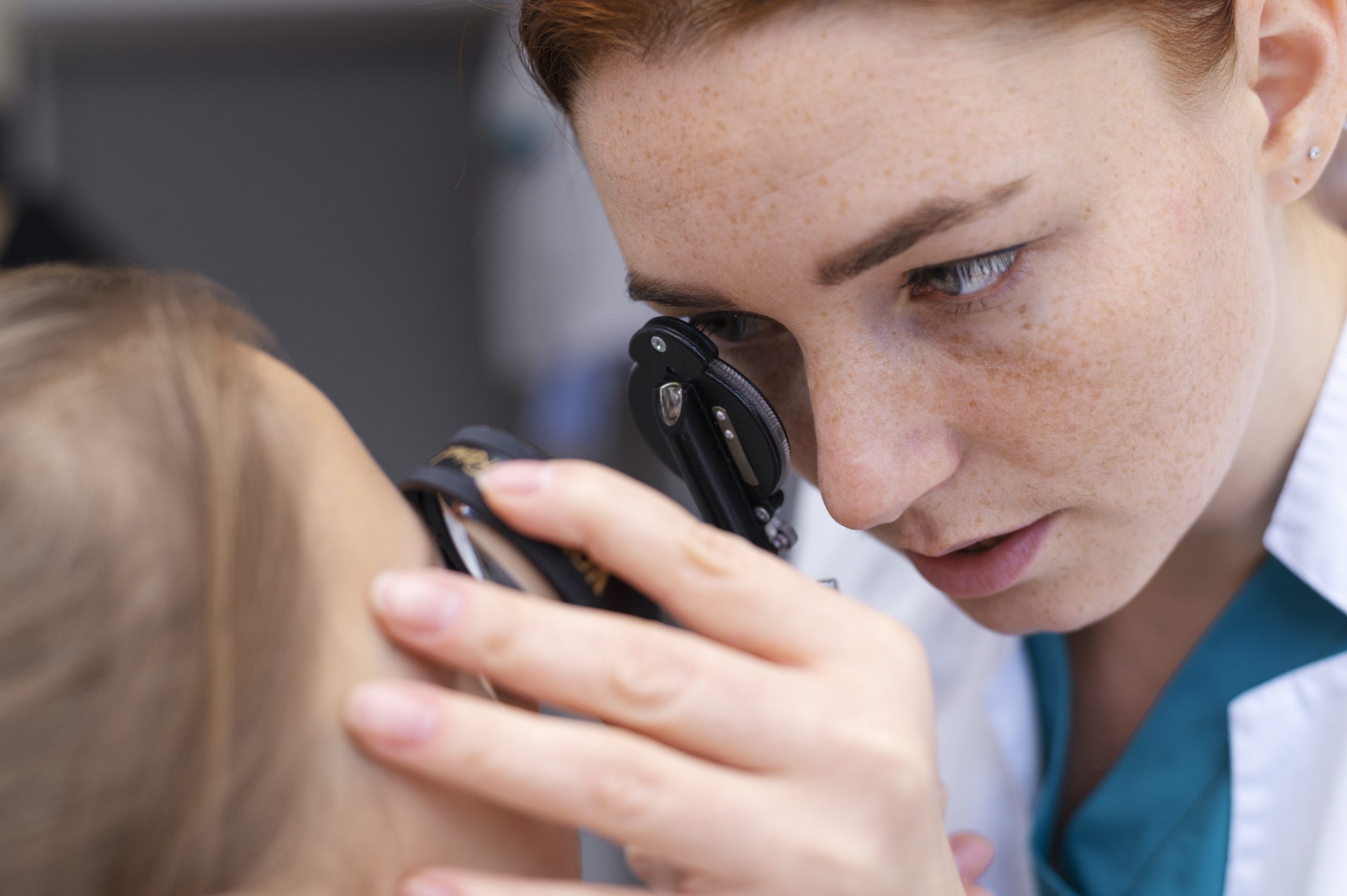When your doctor suspects an eye condition or disease, they may recommend an ultrasound on your eye. It uses sound waves to create detailed images of your eye and surrounding structures. This non-invasive and painless procedure helps identify abnormalities like tumors, retinal detachment, and foreign substances. It evaluates eye trauma, glaucoma, and cataracts. In this article, we’ll explore the uses, preparation, procedure, risks, and results of an eye ultrasound. Understanding its benefits and limitations will help you make informed decisions about your eye health.
Uses and Reasons for Eye and Orbit Ultrasound
Your doctor may recommend an ultrasound on your eye to identify tumors or neoplasms involving the eye. An eye and orbit ultrasound is a non-invasive and painless diagnostic imaging technique that uses sound waves to create detailed images of the eye and its surrounding structures. It is commonly used in ophthalmology and ophthalmic surgery for various purposes. This scan can detect foreign substances in the eye, diagnose detachment of the retina, aid in diagnosing glaucoma, and assist in evaluating cataracts and lens implants. It is also helpful in identifying eye diseases and measuring the thickness and extent of a cancerous tumor, which helps determine the best treatment options. The preparation for an eye and orbit ultrasound is minimal, and the procedure itself takes about 15 to 30 minutes. After the scan, there are no specific restrictions or precautions required, and the results are reviewed by an ophthalmologist. Overall, an eye and orbit ultrasound is a quick, painless, and safe procedure that provides valuable information for the diagnosis and treatment of various eye conditions.
Preparation and Procedure of Eye and Orbit Ultrasound
To prepare for an eye and orbit ultrasound, you do not need to follow any specific preparation instructions. Here is what you can expect during the procedure:
- No pain or discomfort: The eye ultrasound procedure is painless. You may experience temporary blurred vision due to the anesthetic drops used to numb the eye. It is important to avoid rubbing your eyes until the anesthetic wears off.
- Two parts: The eye and orbit ultrasound consists of two parts – A-scan and B-scan. The A-scan measures the eye and helps determine the power of a lens implant before cataract surgery. The B-scan provides structural information about the eye and can detect conditions such as retinal detachment, tumors, and inflammation.
- Duration: The combined procedure typically takes 15 to 30 minutes to complete. The A-scan can be performed while sitting upright or lying down, depending on your comfort.
- Side effects: There are no known side effects associated with eye ultrasound. However, the anesthetic drops used during the procedure may cause temporary blurred vision for a few hours.
An eye and orbit ultrasound is a safe and non-invasive diagnostic procedure that can detect various eye conditions and aid in treatment planning. If you have any concerns or questions about the procedure, it is always best to discuss them with your healthcare provider.
Risks and Results of Eye and Orbit Ultrasound
When discussing the risks and results of eye and orbit ultrasound, it is important to note that one key point is to avoid rubbing your eyes. Rubbing your eyes after the procedure, especially while the anesthetic is still in effect, can potentially scratch the cornea and cause discomfort or complications. Therefore, it is crucial to follow the instructions provided by your healthcare provider and refrain from rubbing your eyes until the anesthetic wears off.
Do not rub your eyes
It is important to consistently avoid rubbing your eyes after undergoing an eye and orbit ultrasound. Rubbing your eyes can have negative effects on the healing process and the accuracy of the ultrasound results. Here are four reasons why you should refrain from rubbing your eyes:
- Prevent Corneal Scratching: Rubbing your eyes can scratch the cornea, especially when it is still numb from the anesthetic drops used during the ultrasound. Scratching the cornea can lead to discomfort, pain, and potential complications.
- Maintain Accurate Results: Rubbing your eyes can cause changes in the position of the structures within the eye, which can affect the accuracy of the ultrasound results. It is important to keep the eye stable and avoid any unnecessary movements.
- Promote Healing: Rubbing your eyes can disrupt the healing process, especially if there were any incisions or injuries during the ultrasound. By avoiding rubbing, you allow the eye to heal properly and minimize the risk of complications.
- Prevent Infection: Rubbing your eyes with unwashed hands can introduce bacteria and increase the risk of infection. It is essential to maintain good hygiene and avoid touching your eyes unnecessarily.
Benefits of Eye and Orbit Ultrasound
Discover the advantages of eye and orbit ultrasound for evaluating and diagnosing various eye conditions and diseases. Eye and orbit ultrasound is a valuable diagnostic imaging technique used in ophthalmology and ophthalmic surgery. It utilizes sound waves to create detailed images of the eye and its surrounding structures. This non-invasive and painless procedure can detect abnormalities such as tumors, foreign bodies, and retinal detachment. It is also helpful in evaluating eye trauma and orbital fractures. Additionally, it aids in the diagnosis of eye diseases like glaucoma and can provide information about cataracts and lens implants. Eye and orbit ultrasound is considered safe as it does not involve exposure to radiation.
This imaging technique provides ophthalmologists with crucial information for determining the best course of treatment. It is particularly useful in measuring the thickness and extent of cancerous tumors, which helps in planning treatment options. Eye and orbit ultrasound offers detailed structural information of the eye, allowing for accurate diagnosis and evaluation of eye conditions and diseases. It is a reliable tool that supports ophthalmologists in providing optimal care for their patients.
Preparing for and Limitations of Eye and Orbit Ultrasound
To properly prepare for an eye and orbit ultrasound, you will need to follow a few important steps:
- Remove contact lenses before the procedure: Contact lenses can interfere with the ultrasound imaging, so it is essential to remove them before the test.
- Inform the healthcare provider about any eye conditions or surgeries: It is crucial to provide your healthcare provider with accurate information about any eye conditions or surgeries you have had. This will help them to interpret the ultrasound results correctly.
- Follow any fasting instructions given by the healthcare provider: In some cases, fasting may be required before the ultrasound test. Your healthcare provider will provide you with specific instructions if fasting is necessary.
- Avoid applying eye makeup or creams on the day of the ultrasound: Eye makeup and creams can interfere with the ultrasound imaging, so it is best to avoid applying them on the day of the test.
It is important to note that there are no known risks or side effects associated with eye and orbit ultrasound. However, it may not be suitable for patients with certain eye conditions or injuries. Additionally, it may not provide clear images in patients with dense cataracts or severe eye inflammation. If you have any concerns or limitations, it is essential to discuss them with your healthcare provider.
Procedure of Eye and Orbit Ultrasound
During an eye and orbit ultrasound, your doctor will use a small instrument called a probe to create images of your eye and its surrounding structures. This procedure is non-invasive and painless, making it a safe and effective diagnostic tool. There is no specific preparation required before the test, and you will be asked to lie on a couch in a comfortable position. The sonographer will apply a clear gel over your closed eyelids and gently move the probe over them. In some cases, the probe may be placed directly on the surface of your eyes. Local anesthetic drops may be used to numb the eye during the procedure. You may experience temporary blurred vision due to the anesthetic drops, so it is advised to avoid driving after the test. The entire procedure typically takes 15 to 30 minutes to complete. After the scan, there are no specific restrictions or precautions required, and you can eat and drink normally. The ultrasound scan is a safe procedure with minimal risk and no radiation involved. The results of the scan will be reviewed by an ophthalmologist, who will determine the best course of treatment based on the findings.
After the Scan of Eye and Orbit Ultrasound
After the eye and orbit ultrasound scan, you will typically receive the results from an ophthalmologist, who will review the findings and determine the best course of treatment based on the information obtained.
Here are four key points to consider after the scan:
- Interpretation of Results: The ophthalmologist will interpret the ultrasound images and measurements to identify any abnormalities or conditions affecting the eye or orbit. They will assess the A-scan measurements to determine the appropriate lens implant power for cataract surgery and evaluate the B-scan images to detect issues like retinal detachment, tumors, and inflammation.
- Treatment Planning: Based on the findings from the ultrasound scan, the ophthalmologist will develop a treatment plan tailored to your specific condition. This may involve medication, surgery, or other interventions aimed at addressing the identified issues and improving your eye health.
- Follow-up Care: Depending on the results of the ultrasound scan, you may need to schedule follow-up appointments with your ophthalmologist. These appointments are essential for monitoring the progress of your treatment, assessing the effectiveness of interventions, and making any necessary adjustments to your care plan.
- Communication and Support: It is important to communicate any concerns or questions you may have to your ophthalmologist. They can provide further explanations, offer guidance, and address any uncertainties or anxieties you may have regarding your eye health.
Risks and Safety of Eye and Orbit Ultrasound
When considering the risks and safety of eye and orbit ultrasound, it is important to understand that this diagnostic imaging technique is generally considered safe and carries minimal risks for patients. Eye and orbit ultrasound uses sound waves to create images of the eye and its surrounding structures, and it is a non-invasive and painless procedure. One of the main benefits of eye and orbit ultrasound is that it does not involve exposure to radiation. There are usually no side effects associated with this test, and it is considered a low-risk diagnostic method.
However, it is important to note that there may be some temporary discomfort or blurred vision after the procedure, especially if anesthetic drops are used. Patients should avoid driving immediately after the test until their vision has fully recovered. Eye and orbit ultrasound may not be suitable for patients with certain eye conditions or injuries, and it may not provide clear images in individuals with dense cataracts or severe eye inflammation. In some cases, other diagnostic tests such as MRI or CT scan may be required to complement the findings of the ultrasound. It is crucial to discuss any concerns or limitations with the healthcare provider to ensure the appropriateness of the test and to determine the best course of action for each individual patient.




